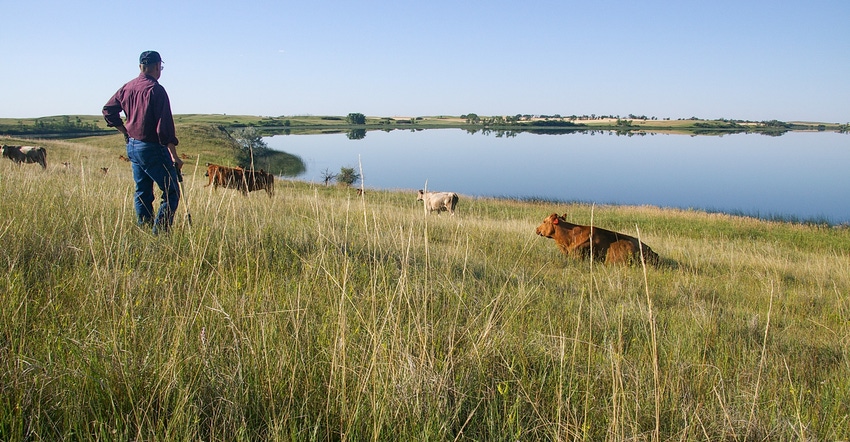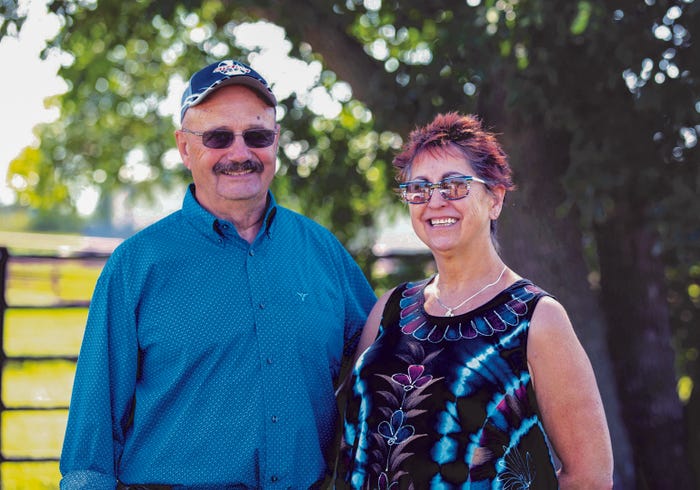
“A thousand little things” have gone into producing more grass and making their ranch more profitable and sustainable, says Gene Goven of Turtle Lake, N.D.
Goven Ranch was named the Leopold Conservation Award winner in North Dakota in 2019. A tour of the ranch that he and spouse, Christine, operate is currently scheduled for July 31 at 1 p.m.
Register for the tour online by July 24 at North Dakota Grazing Lands Coalition.
430% increase
Gene has increased forage production 430% and tripled the pounds of beef produced per acre compared to when he started farming and ranching in 1967.
He used regenerative soil building, intensive grazing management and many innovative conservation stewardship practices long before they were considered mainstream.
The Sand County Foundation, which created the Leopold Award to recognize achievements in private lands conservation, says the Goven Ranch is “home to some of the best rangelands and prairie pothole wetlands in North America.”
The foundation describes the Govens' achievements in and contributions to conservation this way:
“When it comes to agricultural conservation, Gene Goven is a trailblazer.
“He displayed courage in his convictions as he adopted regenerative farming and ranching practices — decades before they were embraced by the mainstream.
“His careful observations of the landscape, livestock and wildlife, informed his farming practices. Today, the positive results of his innovations are clear on the land he purchased in 1967. So is the impact his leadership has had on farmers, ranchers, researchers and educators near and far.
“Gene credits his father and grandfather with teaching him the benefits of growing companion crops like clover to ‘retain armor on the soil.’ Companion cropping is seeding a mixture of cover crops with traditional cash crops. By keeping continuous cover on the ground, the soil is fed additional nutrients, erosion is reduced, water infiltration is increased, and beneficial insects are provided with habitat.
“Even when such practices made him ineligible to receive crop insurance payments, he persevered. He also was an advocate for grazing livestock on public grasslands amid a growing movement against it.
“He convinced many wildlife managers that using livestock as a grassland management tool benefits wildlife.
“As a founding member and past chair of the North Dakota Grazing Land Coalition, Gene calls grazing an art and science.
“As he embraced holistic ranch management in the 1980s, he saw that managing for healthy grasslands would provide his cattle the quality feed they need.
“He installed cross fencing, watering systems, and planned grazing rotations that benefitted cattle and wildlife.
“Goven Ranch is home to some of the best rangelands and prairie pothole wetlands in North America. He received financial assistance from Ducks Unlimited and the Natural Resources Conservation Service for installation of water pipeline and tanks, which kept cattle out of waterways.
“Gene discovered grazing cattle on cover crops built his cropland’s soil health while reducing his input costs, which increased his bottom line.
“For years he took the time to monitor regrowth rates of pastures, native grass and forb species diversity, infiltration rates and organic matter levels on rangeland and cropland. This led him to collaborate with North Dakota State University and other government and private research agencies to interpret and share the results of his observations.
“Gene and his wife, Christine, have engaged in extensive community outreach, including hosting an annual event on the ranch to help expose North Dakota youth to the importance of grasslands.
“Gene provides guidance to others on the importance of soil health, and how cover crops and livestock play a vital role in cropping systems. Perhaps the only thing more impressive than their dedication to their land, is their commitment to sharing what they’ve learned on a 50-year journey in agricultural conservation.
“‘I firmly believe we are no healthier than our soil,’ he says.”
Simple start
Gene’s conservation journey started simply. His pasture was adjacent to Crooked Lake and his cows only grazed close to the lake. The grass on the other end of the pasture wasn’t getting used. He tried some of the standard practices of the day to get them to the other end of the pasture, such as placing mineral and other supplements away from the lake, but nothing worked.
So Gene started building fences. He divided the pasture and added water sources further from the lake. One pasture became two, then four, then eight. Today, Gene has nearly 30 permanent paddocks on about 700 that he can subdivide multiple times. The ranch has an additional 750 acres of cropland, which is used for grazing, too.
Gene watched the land closely as he tried to get his cows to eat more of the grass. He was puzzled by the fact that much of the rain and snowmelt ran off, even when the soil was dry. The soil structure and compaction and shallow rooting depth of the heavily grazed plants seemed to be the problem.
At best, the water infiltration rate was 8/10s of an inch an hour. As he moved cattle faster through the pastures and rested the grasses longer, the soil infiltration rates improved. Today, the poorest fields absorb 6 inches of rain in an hour and the best soak up 10 inches in an hour in an hour.
“I’m trying to capture every of drop of water I get,” he says.
 AWARD WINNERS: Gene and Christine Goven, who operate the Goven Ranch, received the Leopold Conservation Award for their achievements in and advocacy of private lands conservation.
AWARD WINNERS: Gene and Christine Goven, who operate the Goven Ranch, received the Leopold Conservation Award for their achievements in and advocacy of private lands conservation.

Gene has become something of an expert in using cows to harvest the grass without damaging the grass roots. The basics are pretty simple, he says. The No. 1 rule: Don’t let livestock take the second bite of leaf. It’s the second bite that damages the root, he says.
Over the years, Gene has become a big fan of plant biodiversity in his pastures. He used to think that biodiversity meant having many different grass species in a pasture instead of just one or two. Now, he is convinced that forbs are as important to the cattle and range health as the grasses. On native prairie, forbs outnumber grass 5 to 1, he says.
“All I do now is manage diversity for soil health, he says.
Advice and tips
If you are starting out on your soil conservation journey, there are a couple simple things to you can do to measure where you are now with soil health, Gene says.
One is a jump test. Take a spade, stick the tip on the ground and jump on it. Measure how far it goes in the ground. On pastures that have been overgrazed and are eroding, and on farm ground that has been tilled for years, you probably won’t get the space in the ground more than a few inches. Gene can get his spade in the ground 12-15 inches in one jump.
Another is a water infiltration test. Take a 6-inch tall, 6-inch diameter tube — it could be a piece of an auger, coffee can or other cylinder — and sink it 3 inches into the ground. Pour in 444 milliliters of water (about 15 ounces), which is the equivalent of 1-inch of precipitation. Time how long the takes for the water to disappear. NRCS has provided more detailed instructions online.
You can repeat the tests annually to track the changes in the soil.
Meet mentors
On Gene’s conservation journey, it helped to be able to talk to other people interested in soil health, he says.
He went to meetings, field days and workshops to learn from other farmers.
The North Dakota Grazing Lands Coalition and the South Dakota Soil Health Coalition both have mentor programs. Gene is one of the mentors in North Dakota.
Visit the mentor network sites for North Dakota Grazing Lands Coalition and the South Dakota Soil Health Coalition.
Ask why
Finally, ask “why?” a lot, Gene suggests. Question what you are doing. Why are you treating cattle with insecticides? Why do you have flies? Why do you have to use herbicides? Why do you have weeds?
“Get to the reasons for the problem,” he says. “It usually gets back to the land and grass. By asking ‘why?’ you may discover how to correct the problem instead of treating the symptoms.”
Read more about:
AwardsAbout the Author(s)
You May Also Like






